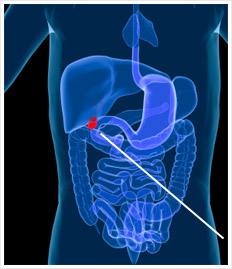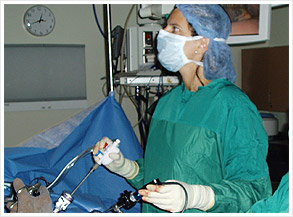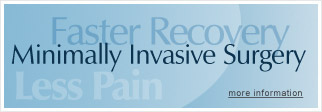Severe Pains In The Abdomen
Do You Have Gallbladder Problems?
Have you had a severe pain in your abdomen, usually near the rib cage on the right side and perhaps with bloating, nausea, or vomiting? This could be due to a diseased gallbladder.
Symptoms usually occur right after a meal. Pain can sometimes radiate to the back or right shoulder. Because symptoms are likely to worsen if they are due to gallstones and left untreated you should consider evaluation and options for relief.
Some groups are more likely to have gallbladder attacks and include:
- Women in their 40's
- Women who have been pregnant
- People who are overweight or have lost a significant amount of weight in a short time period
- People who eat large amounts of dairy products, animal fats, and fried foods, and,
- People with family history.
The gallbladder is located under your liver. It stores and concentrates bile made by the liver.
When a meal is eaten, the gallbladder contracts and squeezes bile through ducts into your small intestines. Bile is a well-balanced mixture of chemicals. If any of these chemicals are out of balance, a sediment develops and forms gallstones.
The gallstones can be trapped in the gallbladder or cystic duct and cause pain or infection. They can also get caught in the liver or common bile duct and cause a back-up of bile into the liver or pancreas, leading to jaundice or pancreatitis.
Evaluation for possible gallbladder disease begins with a medical history and physical exam. Further testing is usually necessary.
Ultrasound is the test of choice. Blood tests can suggest infection or stones trapped in the liver or common bile duct. A nuclear medicine study may be necessary and can help evaluate if the gallbladder is functioning adequately.
Symptomatic gallstones, or cholelithiasis, should be treated. Surgically removing the gallbladder is the treatment of choice.
The gallbladder, although helpful in storing bile, is not necessary. The liver will continue to produce and excrete bile to aid in digestion.
 The gallbladder can be removed with a laparoscope (a telescope-like camera) which is inserted through tiny incisions, along with other instruments, to view and remove the gallbladder.
The gallbladder can be removed with a laparoscope (a telescope-like camera) which is inserted through tiny incisions, along with other instruments, to view and remove the gallbladder.
Sometimes the gallbladder cannot be removed with the laparoscope, so the operation is converted to an open procedure.
A small incision is made below the right rib cage and the gallbladder is removed. Risks and complications include bleeding and infection. Rarely, the bile ducts may be injured or a stone may form in the common bile duct.
Medications can sometimes dissolve gallstones. They work slowly and only on certain types of gallstones. Patients may need to take these drugs for the rest of their lives.
Patients usually go home the next day or same evening after a laparoscopic gallbladder removal. Hospitalization is usually a little longer for open gallbladder removal. After your digestive system returns to normal you will find foods that previously bothered you will no longer have the same effect.
Please call 410-571-9499 for more information. We will be happy to address your questions and concerns.






